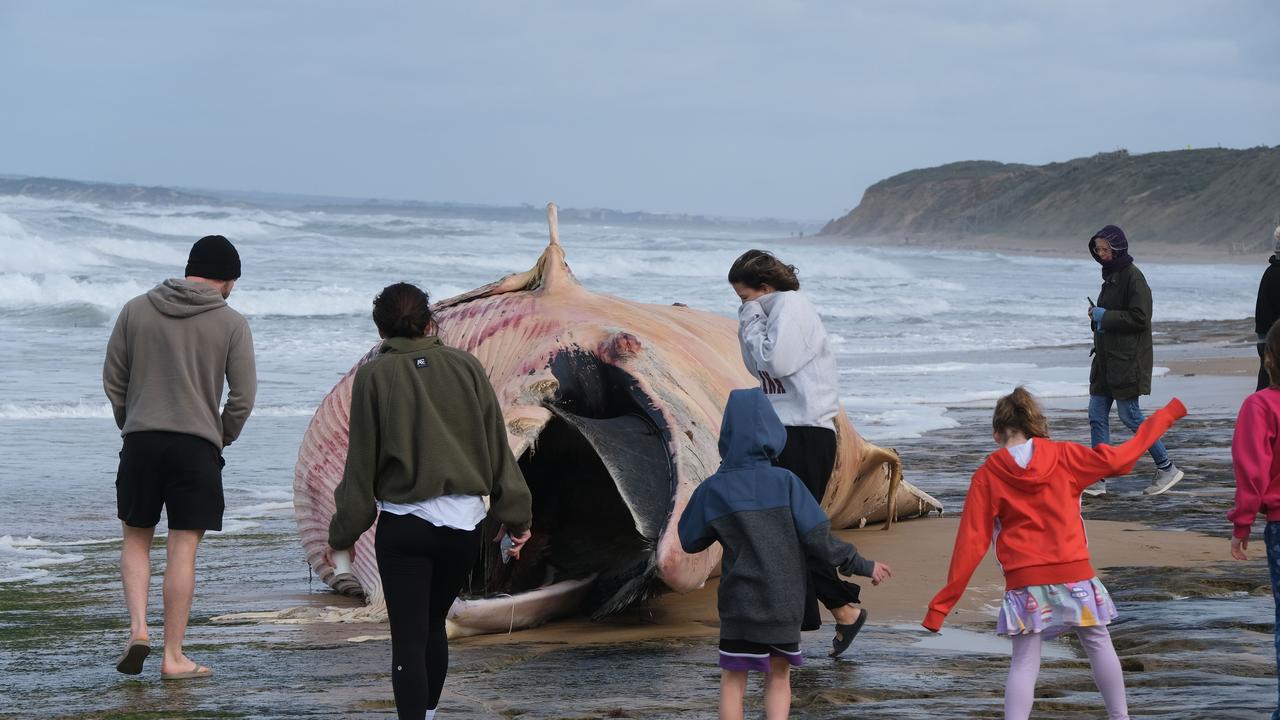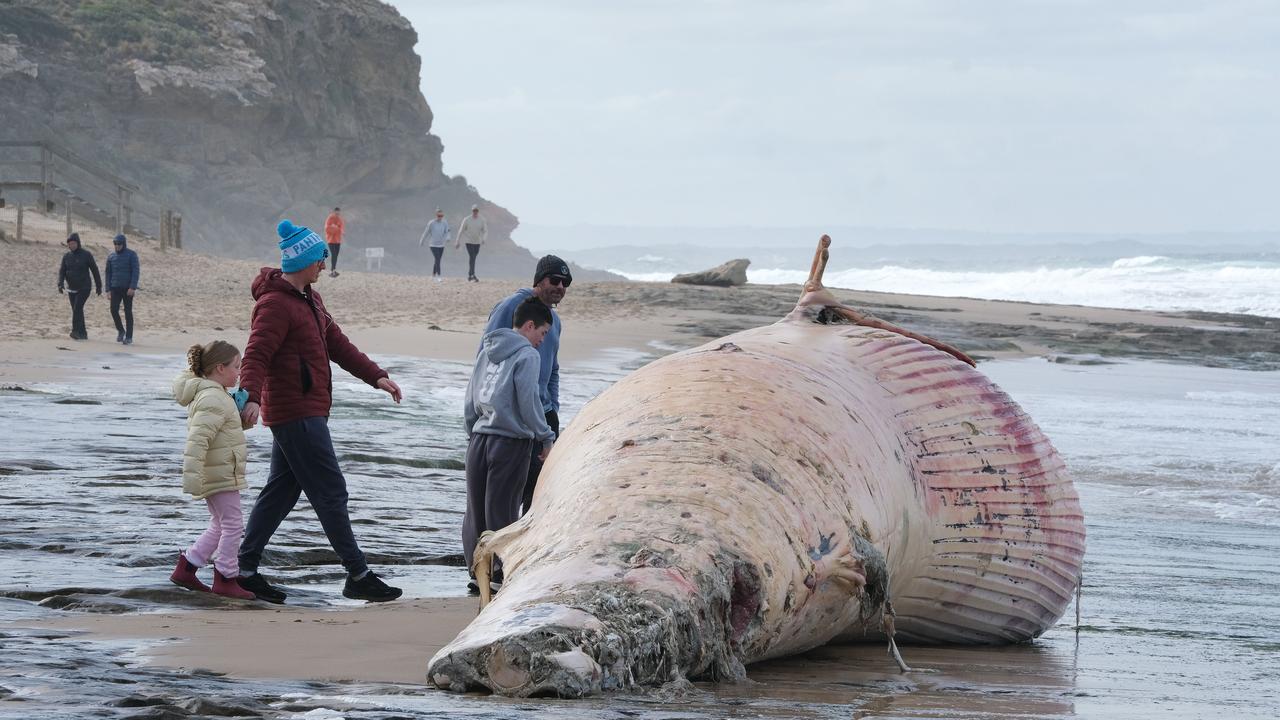Thirteenth Beach whale: Shark alerts, a missing tail, and ‘risk of exploding’
More than a week after a whale washed up on a Barwon Heads beach the carcass is quickly becoming a controversial – and smelly – spot for tourism, and could now be the scene of a crime.
Where did the whale’s tail go?
Will it explode?
When will the water be safe again?
It’s been more than a week since a still unidentified species of whale carcass washed up just west of The Bluff on Thirteenth Beach.
And there’s still a flurry of questions surrounding the whale’s tale – and tail.
The flukes were allegedly stolen this week, sparking an investigation by the Office of the Conservation Regulator.
“Whales are protected under the Wildlife Act 1975, regardless of whether they are alive or deceased,” a spokesman said.

“It is an offence to interfere with, take or be in possession of parts of a deceased whale.”
It is also illegal to get within 300m of the creature, but you wouldn’t know that, judging by the crowds that have flocked to the shoreline to check out the rotting carcass, And what should be done about the mass of blubber remains uncertain too.
While at sea, the creature’s death attracted a spike in shark activity and prompted beach closures between Ocean Grove and Thirteenth Beach.
Once beached, a new swarm quickly formed as the decomposing 14m-long carcass became a temporary and controversial tourist attraction.
A fresh shark warning was issued on Thursday after reports sharks were still moving in closer to shore than normal due to the lingering remains of the dead whale.
All week, The Bluff has been busy with families, children in school uniform, international tourists taking photos, bird and wildlife-watchers and Melburnians who have ventured down the coast to see it up close.
Monash University students Jay Yang and Lydia Kung drove two hours from Melbourne to make a day of seeing the whale.
“We’ll go to dinner in Geelong on the way back,” Mr Yang said. “It was good to see, it feels like a once-in-a-lifetime chance.”
Ms Kung said it smelt like a fishmonger’s shop, but was a special experience regardless.
Drysdale birdwatchers Annie Dickinson and Brad Stone took binoculars along and didn’t get too close, opting to instead sit on the hill nearby and watch for rare wildlife that might be visiting the carcass, such as the petrel albatross.
“I knocked off work early to see it,” Mr Stone said.
“And I’m pretty sure I saw bite marks.”
He said he was also hanging out to see if the whale would explode, a rare but possible occurrence.
“It does look like it’s going to pop,” he said.
“I’m pretty content to leave it there and let nature take its course.”

Ocean Grove resident Dr Samm Sherman, a senior lecturer in fisheries at Deakin University, said the risk of the creature exploding was real, “especially if it warms up”.
“I went to go see it over the weekend, and it looked quite swollen,” he said.
“It’s basically a really big balloon, and as it decomposes, more gases will continue to form.”
But the bigger risks, Dr Sherman said, were sharks, including great whites. Two were spotted circling last week.
“Whales’ carcasses contain a lot of blubber and the oil creates a really clear smell trail,” Dr Sherman said.
“It’s basically breadcrumbs. It could potentially be a problem as they might hang around for a little bit then realise there’s no food.
“Or they could stay in the area still searching for the source.”
The carcass could attract sharks for more than a month, with signs in place warning beachgoers.
“I would not risk it,” Dr Sherman said.
A Victorian Fisheries Authority spokesman said while the beach remained open, it was recommended that swimmers and surfers avoid the area.
Ocean Grove mum Bree Carroll took her boys to visit the whale a few days after it had been beached.
“The boys thought it was too stinky,” she said.
“But they’ve never seen a whale before. I just can’t believe someone’s taken the tail.”
St Leonards resident Peter Debono said the carcass should be pulled back out to sea.
A Department of Energy, Environment and Climate Action spokesman said the whale posed a potential health hazard.
He urged swimmers and surfers to avoid the area.
“We appreciate that while these animals are magnificent to see, we remind everyone to keep their distance for safety reasons,” he said.
Associate Professor Philip Barton, a zoologist and entomologist at the Deakin School of Life and Environmental Sciences, specialises in the decomposition process and how dead animals are recycled.
“When a whale dies (at sea) (we) call it whale fall,” he said.
“They sink to the bottom floor and there is a particular set of animals that help with decomposition.”
Ashore, he said, scavengers including ravens, foxes, sea birds and blowflies were attracted to the carcass, while internal bacteria also broke down the carcass.
“You’ve got a lot of bacteria and a risk of infestation, so it’s best that you leave nature to its course,” he said.
Professor Barton said the risk of the whale exploding a week after being beached was low.
“It has happened, but it’s rare,” he said. “There are footages of whales being blown up by people too.”
In 2018, a whale carcass that washed up at a Bellarine beach was exhumed and taken to a tip amid fears it could attract sharks.
“Our normal response as people is sometimes to try and bury or move it, of those burying it probably the best approach but it will still actually slow down that decomposition process.”
As for why someone would take the tail: “Look, I don’t know why someone would do that, it’s just a weird thing to do.”
More Coverage
Originally published as Thirteenth Beach whale: Shark alerts, a missing tail, and ‘risk of exploding’






